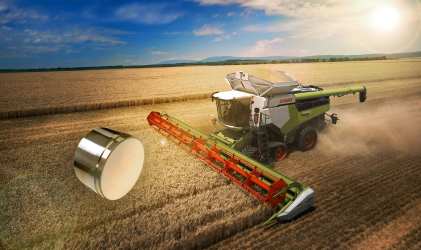
The CAN bus is used in on- and off-road applications, vehicles in the construction and agricultural sectors as well as in engines. The CAN bus is integrated in the sensor.
The sensor meets critical EMC and environmental requirements. The signals are integrated and processed directly in the customer's control. The CAN bus signals communicate directly with the control apparatus.
Measurement by the Liebherr sensor system is based on the physical principle of capacitance determination in the high-frequency stray field.
In addition to their high precision and robustness, the sensor system from Bad Schussenried is characterised by its reproducibility.
Each CAN sensor is individually calibrated and final tested.
Benefits
- Indirect measuring method: Capacity determination in the high frequency stray field. This method uses the different dielectric constant (permittivity) of water and different materials (solids and liquids).
- Fully reproducible sensors: If the plant is subsequently extended with sensors or if sensors are replaced, no recalibration is necessary thanks to the built-in microprocessor.
- Waterproof and dustproof: The sensor is also suitable for the harshest environments thanks to its IP68/IPX9K protection class.
- Process control and regulation: Thanks to extensive interfaces, the moisture measurement can be integrated into process control systems and controls.
- Cost saving: Time-consuming and costly laboratory analyses are no longer necessary or can be reduced.
- Temperature measurement/temperature compensation: The sensor can also be used to determine the temperature of the medium.
- Limit values: Maximum or minimum limits can be set using the software. Light or sound signals can be triggered if required.
- Median filter and mean value calculator: The sensor passes on already averaged values to the higher-level control.
| Sensor basic data |
|
| Diameter with collar |
80.0 mm |
| Diameter without collar |
78.0 mm |
| Housing height |
43.1 mm |
| Height with socket |
56 mm |
| Weight |
0.625 kg |
| Housing material |
Stainless steel 1.4305 |
| Cover material |
Stainless steel 1.4301 |
| Wear plate material |
Ceramic AI203 |
| Process connection |
Clamping flange |
| Protection class |
IPX9K/IP68 |
| Sensor exchange without recalibration |
Yes |
| Technology |
Streaming |
| Sensor for moisture content |
|
| Measured variable |
Electrical permittivity high resolution, depending on material moisture content and material density |
| Frequency |
21-25 MHz |
| Operating temperature |
5-70 °C |
| Material penetration depth (depending on material) |
3-5 (measuring part influence decreasing exponentially with depth) cm |
| Sensors for temperature |
|
| Measured variable |
Open the 1st Oscillator temperature
Open the 2nd Plate temperature |
| Output temperature resolution |
0.01 K |
| Measuring range |
-10 to 80 °C |
| Measurement value transfer |
|
| Bus type |
CAN 2.0 B ISO 16845 certified |
| Baud rate |
250,000 bit/s |
| Transceiver |
3.3 V cross-circuit protection, overvoltage protection up to +/- 36 V, loss of ground protection, overheating protection (thermal shutdown) and common-mode transient protection of +/- 100 V |
| Bus scheduling |
External, internal possible |
| Electrical connection |
|
| Supply voltage |
12 (min/max 6-36) V |
| Power consumption |
0.3 Amax/17 mA@12V |
| Reverse polarity protection |
Yes |
| Connection |
|
| Connection |
DEUTSCH DT 15-4P |
| 0V/GND |
Pin 1 |
| CAN-Low |
Pin 2 |
| CAN-High |
Pin 3 |
| +12V |
Pin 4 |
| CAN messages |
|
| Format identifier |
29-Bit-Identifier, Extended frame format |
| Number of bytes in the data field (DLC) |
8 |
| Measured value identifier |
0x01505043 |
| NTC1 |
Electronics temperature: Integer with 2 decimal places
Indication: °C + 40 °C |
| NTC2 |
Temperature behind ceramic plate: Integer with 2 decimal places
Indication: °C + 40 °C |
| C_value |
Humidity sensor capacity value: Integer with 2 decimal places |
Documentation
 flyer-litronic-fms-p80-can_en
flyer-litronic-fms-p80-can_en
 data-sheet-planar-sensor-p80-can
data-sheet-planar-sensor-p80-can